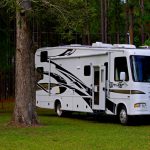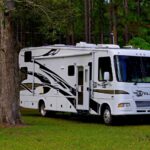
Are you dreaming of trading your traditional home for the freedom of stationary RV living? You’re not alone! Many adventurers are discovering the joys of living in an RV, but before you hit the road (or park it in one spot), understanding the true costs involved is crucial. In this comprehensive guide, we dive deep into the 15 essential insights about stationary RV living costs that will help you make informed decisions.
Did you know that RV living can save you thousands of dollars compared to traditional homeownership? Imagine waking up to a new view every day while keeping your expenses in check! But it’s not all sunshine and rainbows; there are hidden costs and considerations that could surprise you. For instance, how do campground fees stack up against mortgage payments? We’ll explore that and much more!
So, buckle up as we take you through the financial landscape of stationary RV living, revealing tips, tricks, and insights that will empower you to embrace this adventurous lifestyle without breaking the bank!
Key Takeaways
- Cost Efficiency: Stationary RV living can be significantly cheaper than traditional housing, with monthly expenses ranging from $450 to $1,450.
- Campground Fees: Expect to pay between $200 to $800 monthly for campground fees, depending on location and amenities.
- Utilities and Maintenance: Budget around $100 to $300 for utilities and $100 to $200 for routine maintenance each month.
- Insurance Matters: RV insurance is generally more affordable than homeowners insurance, but coverage varies based on the RV type and location.
- Flexibility and Freedom: Enjoy the ability to relocate and explore new environments, making RV living an attractive option for many.
Ready to dive deeper into stationary RV living? 👉 CHECK PRICE on:
- BLUETTI Solar Generators: Amazon | Camping World
- RV Memberships: Good Sam | Passport America
Let’s get started on your journey to RV living! 🚐✨
Table of Contents
- Quick Tips and Facts About Stationary RV Living Costs
- Understanding the Costs of Stationary RV Living
- Comparing the Cost of Living in a House vs. an RV
- Breaking Down the Expenses of Full-Time RV Living
- Stationary RV Living vs. Full-Time RV Travel: What’s the Difference?
- Pros and Cons of Stationary RV Living vs. Homeownership
- Money-Saving Tips for Stationary RV Living
- How to Power Your RV: Energy Costs Explained
- Insurance and Maintenance Costs for Stationary RV Living
- Budgeting for Stationary RV Living: A Comprehensive Guide
- Lifestyle Adjustments: What to Expect When Living in an RV
- Final Words on Stationary RV Living Costs
- Recommended Links for RV Enthusiasts
- Frequently Asked Questions About RV Living Costs
- Reference Links for Further Reading
Quick Tips and Facts About Stationary RV Living Costs
Welcome to the world of stationary RV living! Whether you’re a seasoned road warrior or a newbie contemplating this lifestyle, understanding the costs is crucial. Here are some quick tips and facts to get you started:
- Cost Efficiency: Living in an RV can be cheaper than traditional housing if done right. Is Living in an RV a Good Idea?
- Location Matters: Campground fees vary widely. Expect to pay between $200 to $800 monthly depending on the amenities and location.
- Utility Costs: Typically range from $100 to $300 per month. Solar panels can help reduce this.
- Maintenance: Regular upkeep is necessary to avoid costly repairs. Set aside a budget for this.
- Insurance: Generally lower than homeowner’s insurance but varies based on RV type and location.
- Freedom and Flexibility: The ability to change your surroundings is both a blessing and a responsibility.
- Depreciation: Unlike a house, an RV depreciates over time. Keep this in mind if considering an RV as an investment.
Fun Fact:
Did you know that living in an RV can help you reduce your carbon footprint? With fewer utilities and the potential for solar power, it’s a greener way to live! 🌱
Understanding the Costs of Stationary RV Living
Let’s dive into the nitty-gritty of stationary RV living costs. It’s not just about saving money; it’s about understanding where your dollars go to live comfortably and sustainably.
1. Campground Fees
Campground fees can range from $200 to $800 per month, depending on location and amenities. Coastal or tourist-heavy areas tend to be pricier. Some campgrounds offer discounts for long-term stays, so it’s worth asking!
2. Utilities and Energy Costs
Utilities in an RV include electricity, water, and sewer. Costs can be reduced through:
- Solar Power: Investing in solar panels can significantly cut electricity costs. Check out options like BLUETTI Solar Generators.
- Propane: Used for heating and cooking, propane costs vary based on usage and season.
3. Maintenance and Repairs
Regular maintenance is key to avoiding hefty repair bills. Budget around $100-$200 monthly for routine checks and small repairs. Learn basic DIY skills to handle minor issues yourself.
4. Insurance
Insurance for an RV is generally more affordable than homeowner’s insurance. However, coverage varies based on the RV’s value, location, and usage. It’s wise to shop around for the best rates.
5. Depreciation
Unlike a traditional home, an RV depreciates over time. Keep this in mind if you’re considering your RV as a long-term investment.
Comparing the Cost of Living in a House vs. an RV
The age-old question: Is it cheaper to live in an RV than in a house? Let’s break it down:
Cost of Living in a House
| Expense | Monthly Cost | Annual Cost |
|---|---|---|
| Mortgage/Rent | $1,200 – $2,500 | $14,400 – $30,000 |
| Property Tax | N/A | $2,000 – $10,000 |
| Insurance | $100 – $200 | $1,200 – $2,400 |
| Utilities | $200 – $500 | $2,400 – $6,000 |
| Maintenance | N/A | $2,000 – $8,000 |
| Total | $1,500 – $3,200 | $22,000 – $56,400 |
Cost of Living in an RV
| Expense | Monthly Cost | Annual Cost |
|---|---|---|
| Campground Fees | $200 – $800 | $2,400 – $9,600 |
| Utilities | $100 – $300 | $1,200 – $3,600 |
| Insurance | $50 – $150 | $600 – $1,800 |
| Maintenance | $100 – $200 | $1,200 – $2,400 |
| Total | $450 – $1,450 | $5,400 – $17,400 |
Conclusion: While RV living can be cheaper, it requires a minimalist lifestyle and careful budgeting. The flexibility to relocate and lower utility costs are significant advantages.
Breaking Down the Expenses of Full-Time RV Living
Full-time RV living isn’t just about hitting the open road; it’s about understanding the costs involved. Here’s a detailed breakdown:
1. RV Purchase and Financing
- Initial Cost: The price of an RV can vary widely based on type and features.
- Financing: Monthly payments range from $225 to $650 depending on the loan terms and down payment.
2. Fuel Costs
Fuel is a major expense for those who travel frequently. The average monthly cost is between $200 and $400, depending on travel distance and fuel efficiency.
3. Food and Groceries
Cooking in your RV can save money. Budget around $500 to $1,000 monthly for groceries, depending on your lifestyle and dietary preferences.
4. Entertainment and Connectivity
- Internet: Essential for remote work and entertainment. Consider mobile hotspots or campground Wi-Fi.
- Activities: Budget for local attractions and hobbies.
5. Hidden Costs
- Laundry: If your RV doesn’t have a washer/dryer, factor in laundromat costs.
- Storage: If you need to store your RV, fees can range from $50 to $100 per month.
Pro Tip: Consider joining RV clubs for discounts on camping fees and other amenities.
Stationary RV Living vs. Full-Time RV Travel: What’s the Difference?
Choosing between stationary RV living and full-time travel is like choosing between a cozy cabin and a nomadic adventure. Here’s how they stack up:
Stationary RV Living
Pros:
- Stability: Consistent location means lower travel costs.
- Community: Build relationships with fellow RVers.
- Routine: Easier to maintain a regular schedule.
Cons:
- Limited Scenery: Same view every day.
- Campground Fees: Can add up over time.
Full-Time RV Travel
Pros:
- Adventure: Constantly changing landscapes.
- Flexibility: Move with the seasons or your whims.
- Experiences: Discover new places and cultures.
Cons:
- Fuel Costs: Higher due to frequent travel.
- Uncertainty: Finding spots to stay can be challenging.
Bottom Line: Your choice depends on your lifestyle preferences and budget. Want more insights? Check out our Full-Time RVing guide.
Pros and Cons of Stationary RV Living vs. Homeownership
The debate between stationary RV living and traditional homeownership is like comparing apples to oranges. Let’s explore the pros and cons:
Pros of Stationary RV Living
- Lower Costs: Generally cheaper than homeownership.
- Flexibility: Easier to relocate.
- Minimalism: Encourages a simpler lifestyle.
Cons of Stationary RV Living
- Depreciation: RVs lose value over time.
- Space Limitations: Less room for belongings and guests.
- Maintenance: Regular upkeep is essential.
Pros of Homeownership
- Investment: Potential for property value appreciation.
- Space: More room for family and activities.
- Stability: Fixed location and community ties.
Cons of Homeownership
- High Costs: Mortgage, taxes, and maintenance add up.
- Inflexibility: Harder to move.
- Upkeep: Requires significant time and money.
Final Thought: Both lifestyles have unique benefits and challenges. Consider your priorities and financial situation when deciding.
Money-Saving Tips for Stationary RV Living
Living in an RV doesn’t mean you have to sacrifice comfort or your wallet. Here are some savvy tips to keep costs down:
1. Choose Affordable Campgrounds
- Research: Look for campgrounds offering long-term discounts or free boondocking sites.
- Memberships: Join RV clubs like Good Sam or Passport America for discounts.
2. Optimize Fuel Efficiency
- Route Planning: Avoid unnecessary detours and maintain a steady speed.
- Vehicle Maintenance: Keep your RV in top shape to improve fuel economy.
3. Embrace Minimalism
- Declutter: Keep only essential items to reduce weight and fuel consumption.
- Multi-Purpose Items: Invest in versatile tools and furniture.
4. Cook at Home
- Meal Planning: Prepare meals in your RV kitchen to save on dining out.
- Bulk Buying: Stock up on non-perishable items during sales.
5. Perform Regular Maintenance
- DIY Skills: Learn basic repairs to avoid costly professional services.
- Preventative Care: Regular checks can prevent major issues.
Pro Tip: Use solar panels to cut down on electricity costs. Check out BLUETTI Solar Generators for reliable options.
How to Power Your RV: Energy Costs Explained
Powering your RV efficiently is crucial for both comfort and cost savings. Let’s explore your options:
1. Solar Panels
- Benefits: Reduce reliance on campground electricity and save on utility bills.
- Options: Consider brands like BLUETTI for high-quality solar generators.
2. Generators
- Usage: Ideal for off-grid camping or as a backup power source.
- Considerations: Ensure your generator is quiet and fuel-efficient.
3. Shore Power
- Availability: Most campgrounds offer electrical hookups.
- Cost: Typically included in campground fees but varies by location.
4. Battery Systems
- Purpose: Store power for use when solar or shore power isn’t available.
- Upgrades: Lithium batteries offer longer life and better performance than traditional lead-acid batteries.
Pro Tip: Monitor your power usage to prevent overloading your system. Investing in energy-efficient appliances can also help reduce consumption.
Insurance and Maintenance Costs for Stationary RV Living
Insurance and maintenance are essential aspects of RV living. Here’s what you need to know:
1. RV Insurance
- Coverage: Includes liability, collision, and comprehensive options.
- Factors Affecting Cost: RV type, age, location, and usage.
- Savings Tip: Compare quotes from different providers to find the best rate.
2. Regular Maintenance
- Routine Checks: Inspect tires, brakes, and fluid levels regularly.
- Seasonal Care: Prepare your RV for different weather conditions to avoid damage.
- DIY Skills: Learn basic repairs to save on service costs.
3. Unexpected Repairs
- Emergency Fund: Set aside funds for unexpected repairs or breakdowns.
- Extended Warranties: Consider purchasing for added peace of mind.
Pro Tip: Keeping a maintenance log can help track repairs and identify recurring issues.
Budgeting for Stationary RV Living: A Comprehensive Guide
Creating a budget is key to enjoying a stress-free RV lifestyle. Here’s how to get started:
1. Assess Your Income and Expenses
- Income Sources: Consider all sources, including remote work or retirement funds.
- Fixed Expenses: Include campground fees, insurance, and utilities.
2. Plan for Variable Costs
- Fuel and Travel: Account for any planned trips or excursions.
- Food and Entertainment: Budget for groceries and activities.
3. Emergency Fund
- Savings Goal: Aim to save a few months’ worth of expenses for emergencies.
- Unexpected Costs: Factor in potential repairs or medical expenses.
4. Track Your Spending
- Tools: Use budgeting apps or spreadsheets to monitor your finances.
- Adjustments: Be flexible and adjust your budget as needed.
Pro Tip: Regularly review your budget to identify areas for savings or improvement.
Lifestyle Adjustments: What to Expect When Living in an RV
Transitioning to RV living involves more than just moving into a new space. Here’s what to expect:
1. Space Management
- Downsizing: Embrace a minimalist lifestyle by reducing clutter.
- Organization: Use storage solutions like collapsible bins and hanging organizers.
2. Daily Routines
- Adaptability: Be prepared to adjust routines based on your location and resources.
- Flexibility: Embrace the freedom to change plans and explore new opportunities.
3. Community and Social Life
- Connections: Join RV communities online or at campgrounds to meet like-minded individuals.
- Activities: Participate in events or volunteer opportunities to stay engaged.
4. Mental and Emotional Well-being
- Mindfulness: Practice mindfulness and self-care to maintain a positive mindset.
- Challenges: Be prepared for challenges like limited space and maintenance tasks.
Pro Tip: Approach RV living with an open mind and a sense of adventure. The experiences and memories you’ll create are invaluable!
With these insights, you’re well-equipped to navigate the costs and lifestyle of stationary RV living. Ready to hit the open road or settle into a cozy campground? The choice is yours! 🚐✨
Final Words on Stationary RV Living Costs
In conclusion, stationary RV living can be a fantastic alternative to traditional homeownership, offering freedom, flexibility, and the potential for significant cost savings. However, it’s essential to weigh the pros and cons carefully.
Positives:
- Lower Monthly Expenses: RV living can cost significantly less than maintaining a home.
- Community and Lifestyle: Enjoy a sense of community with fellow RV enthusiasts, and experience a simpler lifestyle.
- Flexibility: Move your home to new locations as desired, allowing for adventure and exploration.
Negatives:
- Depreciation: RVs lose value over time, unlike homes which can appreciate.
- Limited Space: Less room for belongings and guests can feel cramped.
- Maintenance: Regular upkeep is necessary to avoid costly repairs.
Ultimately, if you’re looking for a minimalist lifestyle with the freedom to travel or settle in beautiful locations, stationary RV living is worth considering. Just be prepared for the unique challenges it brings!
Recommended Links for RV Enthusiasts
- 👉 Shop BLUETTI Solar Generators on: Amazon | Camping World
- Check out RV Memberships on: Good Sam | Passport America
- Explore Essential RV Living Books on Amazon:
Frequently Asked Questions About Stationary RV Living Costs
What is a good budget for full-time RV living?
A good budget for full-time RV living typically ranges from $1,600 to $5,000 per month, depending on your lifestyle and choices. This includes costs like campground fees, utilities, insurance, food, and maintenance. For a frugal lifestyle, some individuals manage to live on as little as $1,000 per month by utilizing free camping options and minimizing expenses.
Is living in an RV cheaper than a house?
Yes, living in an RV can be cheaper than a house, particularly if you consider the ongoing costs associated with homeownership, such as mortgage payments, property taxes, and maintenance. However, the total cost can vary based on factors like location, RV type, and lifestyle choices.
Is it financially smart to live in an RV?
Living in an RV can be financially smart if you prioritize a minimalist lifestyle and are willing to adapt to the unique challenges it presents. Many find that they can save money on housing costs and enjoy the freedom of mobility, but it requires careful budgeting and planning.
Is living in an RV full-time worth it?
For many, living in an RV full-time is worth it! The ability to travel freely, explore new places, and simplify life is appealing. However, it may not be for everyone, especially those who prefer stability and more living space. Ultimately, it depends on your personal preferences and lifestyle goals.
What are some hidden costs of RV living?
Hidden costs of RV living can include:
- Laundry: If your RV lacks a washer/dryer.
- Storage Fees: For when you’re not actively using your RV.
- Toll Roads: Depending on your travel routes.
- Emergency Repairs: Always budget for unexpected issues.
How can I save money while living in an RV?
To save money while living in an RV:
- Utilize boondocking (free camping).
- Join RV clubs for discounts.
- Cook meals at home to reduce dining expenses.
- Maintain your RV to avoid costly repairs.
Reference Links for Further Reading
With this comprehensive guide, you’re ready to embark on your RV journey with confidence! Happy travels! 🚐✨




